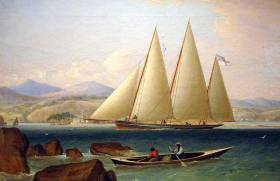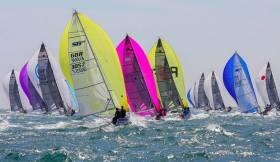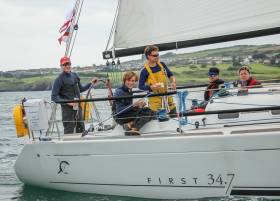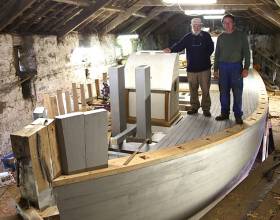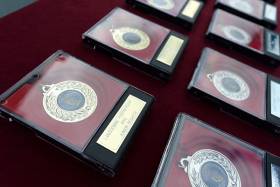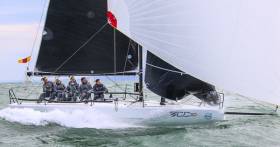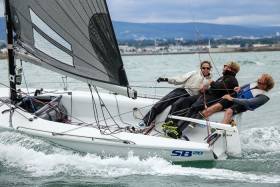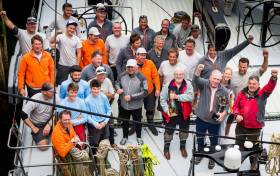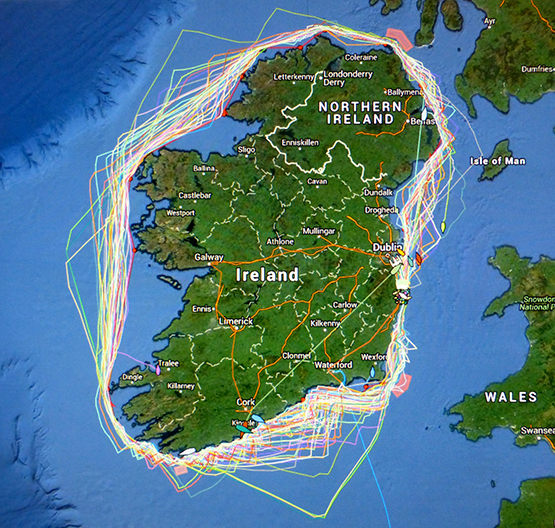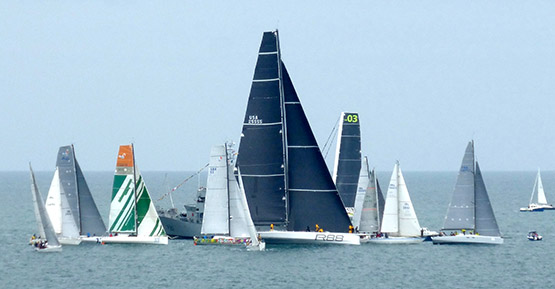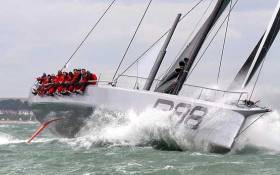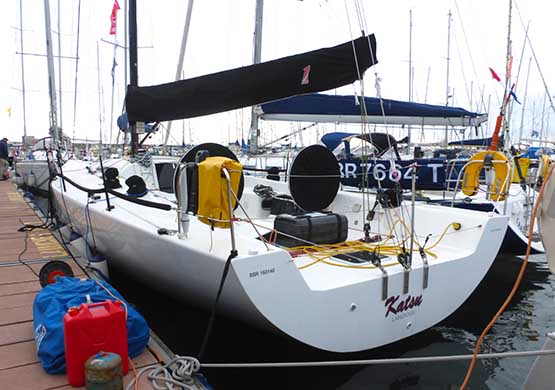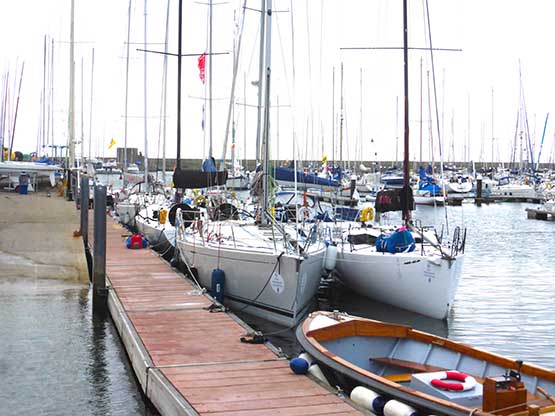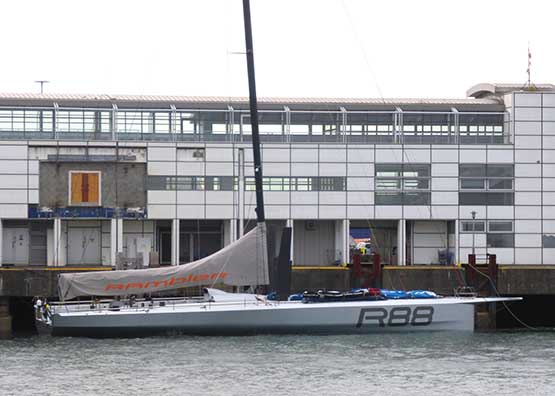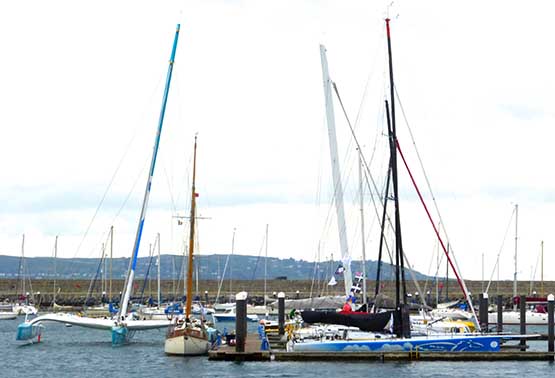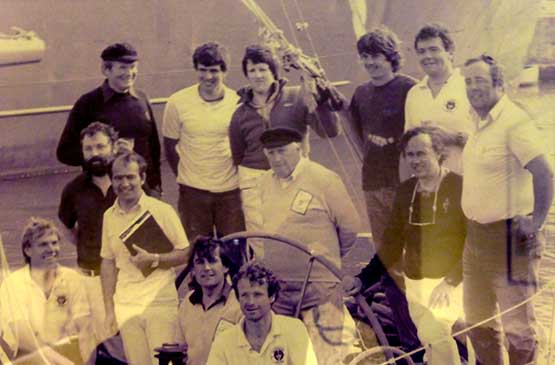Displaying items by tag: Royal Irish Yacht Club
Sailing's Gaff Rig: Ireland's Part in its Downfall
The 35th staging of international races for the 176-year-old America’s Cup is rising rapidly up the agenda. The opening jousts for challengers begin on 26th May 2017 at the first-time-selected venue of Bermuda, and the cup series itself starts there on 17th June. It’s time to focus on the sailing paradise of Bermuda, and particularly its role in changing the shape of sails in mainstream sailing. W M Nixon takes a typically skewed look at what it all might mean.
The irony of it is that, long before the rig was popularly accepted, it was the sailors of Bermuda who were credited with the invention of the jib-headed triangular shape for mainsails. This dominated yacht design for nearly a century. Yet in 2017, as the inevitably trend-setting America’s Cup finally comes to Bermuda for the first time, it will be raced by sailing machines – the word “boats” seems inadequate – which are setting what looks very like an extremely modern variation of the classic gaff rig.
For what are today’s state-of-the-art square-headed mainsails other than an attempt to get as much sail area as possible within the limits set by the height of the mast and the length of the boom? And what rig was based on the same premise? Exactly. The gaff rig, and its very useful cousin, the sprit rig.
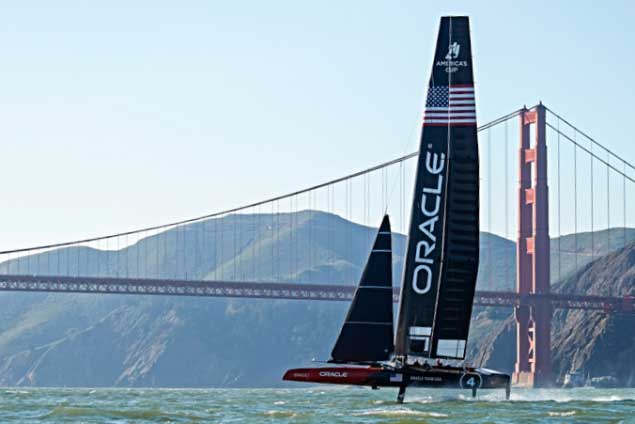 Is this or is this not gaff rig? America’s Cup defenders Oracle in action off San Francisco
Is this or is this not gaff rig? America’s Cup defenders Oracle in action off San Francisco
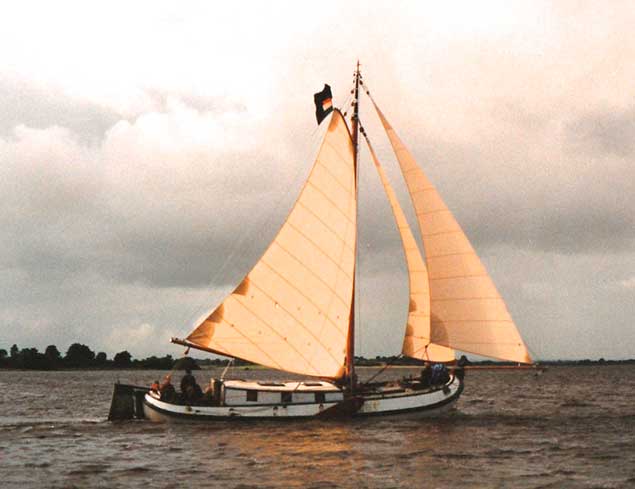 David Beattie’s Dutch Lemsteraak Schollevaer, sailing here on Lough Ree, indicates that classic Dutch yachts tended towards shortening their gaff booms to such an extent that for a period they were almost Bermudan rigged. Photo: W M Nixon
David Beattie’s Dutch Lemsteraak Schollevaer, sailing here on Lough Ree, indicates that classic Dutch yachts tended towards shortening their gaff booms to such an extent that for a period they were almost Bermudan rigged. Photo: W M Nixon
Yet at a certain stage, as the pioneering Dutch yachtsmen moved from the sprit rig to the gaff rig, the gaff booms became so short that the sailing world was very close to having jib-headed mainsails. But boats setting bisquine rig or something very similar showed what could be done with topsails, and longer gaff booms with topsails above them became the norm.
In due course, the logic of having lighter masts, and mainsail and topsail one and the same with no booms between them, became inescapable. Yet because so many people, relatively speaking, had by this time taken up sailing, the arguments about which rig, gaff or Bermudan, was superior soon became ludicrously heated.
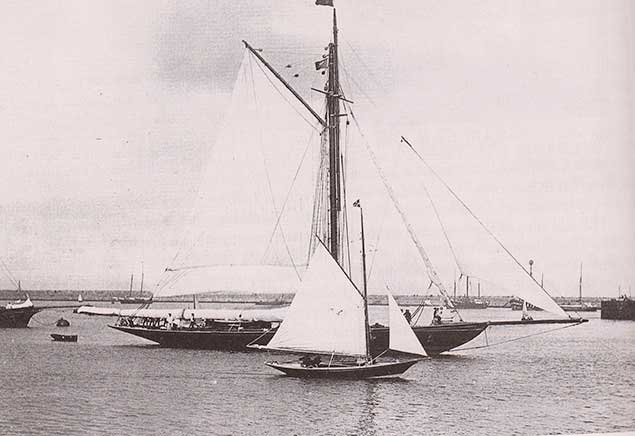 The Prince of Wales cutter Britannia in Dun Laoghaire in 1893, newly-built and on passage from the Clyde to the Solent, showing how a racing gaff rig could be shortened down for sea-going passages in heavy weather, with the topmast safely housed and a loose-footed gaff-headed trisail set instead of the full mainsail.
The Prince of Wales cutter Britannia in Dun Laoghaire in 1893, newly-built and on passage from the Clyde to the Solent, showing how a racing gaff rig could be shortened down for sea-going passages in heavy weather, with the topmast safely housed and a loose-footed gaff-headed trisail set instead of the full mainsail.
Traditionalists argued that while Bermudan rig might be just about acceptable for inshore racing in sheltered water, anyone going cruising or racing offshore needed the rugged gaff rig with its compact mast, possibly heightened by a topmast which could he lowered and housed against the forward side of the mainmast when at sea and conditions deteriorated.
And then there were and still are the uber-traditionalists who argue that if gaff rig had been good enough for their fathers and forefathers before them, then it was good enough for them, and you don’t have to go any further than Howth, Connemara or Falmouth to find them in their droves.
A new factor entered the equation with the development of the heritage industry, which concluded that that the loss of familiarity with handling the formerly-universal gaff rig was a real cultural threat. So in 1963 the Old Gaffers Association came into being at much the same time as the Classic Yacht Movement was starting to gain traction, and thus the preservation of gaff rig was being upheld from both ends of the wealthy to barely-getting-by spectrum.
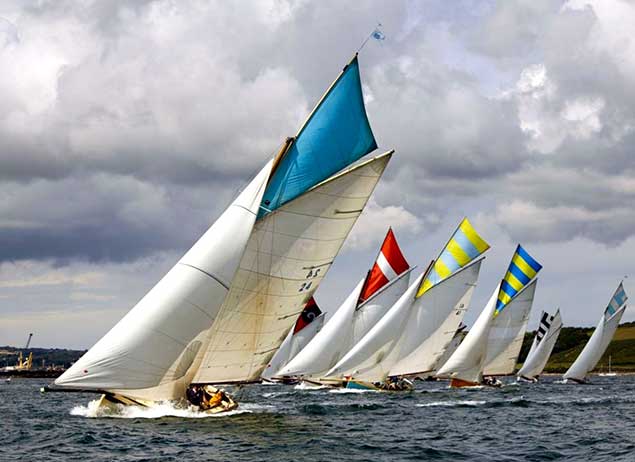 Where gaff rig is the norm – Falmouth Working Boats racing. Under ancient legislation, it is only permissible to dredge for oysters in Falmouth Harbour under sail, and the working boat with adjustable performance has developed as a result.
Where gaff rig is the norm – Falmouth Working Boats racing. Under ancient legislation, it is only permissible to dredge for oysters in Falmouth Harbour under sail, and the working boat with adjustable performance has developed as a result.
It was all great fun if you didn’t take it took seriously, but in its day, some people took it very seriously indeed and a few still do, so we’ll give the pot a very good stir by revealing that it was Irish sailors who played a key role in making Bermudan rig mainstream.
Our header image reveals that Bermudan rig in a quite sophistcated form was not unknown from 1834 onwards. But nevertheless even in crack yachts like Belfast linen magnate John Mulholland’s schooner Egeria of 1865 vintage, and John Jameson of Dublin’s cutter Irex designed by Alexander Richardson in 1884, the relatively crude gaff topsails being set still showed how closely they were descended from lug rigs which in turn had evolved from trying to get simple squaresails to set closer to the wind.
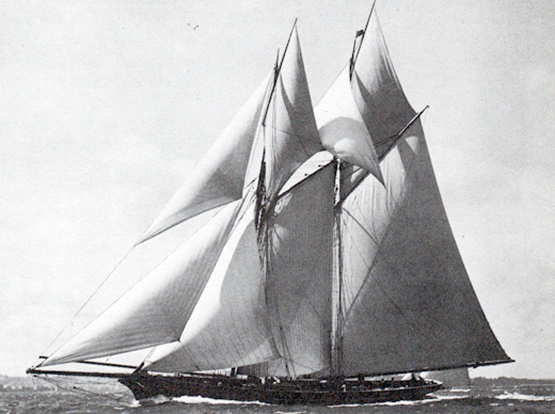 John Mulholland’s 99ft schooner Egeria of 1865 vintage set topsails which were developments of lug sails
John Mulholland’s 99ft schooner Egeria of 1865 vintage set topsails which were developments of lug sails
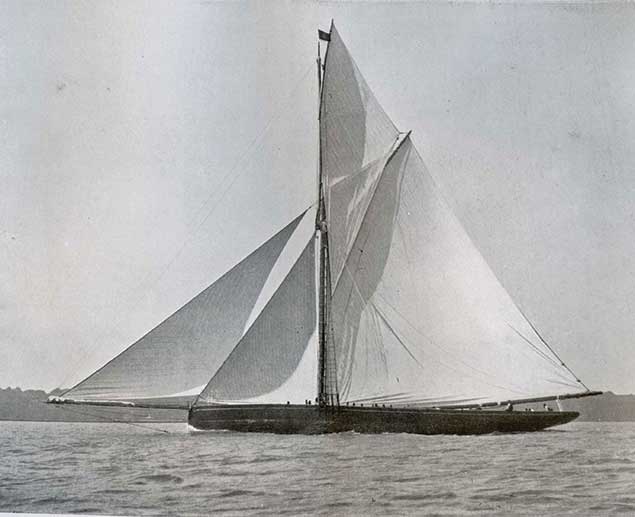 John Jameson’s Irex of 1884 originally set a topsail which looked very out-of-date just ten years later
John Jameson’s Irex of 1884 originally set a topsail which looked very out-of-date just ten years later
But by the late 1880s, topsails were becoming more clearly jib headed, and for a while they used a combination of short mainmast, a short topmast, and a topsail yard to provide their height, which could resulted in a distinctly stunted look when on a dead run, as is seen in the Scottish ironmaster Peter Donaldson’s all-conquering 70ft 40-rater Isolde, designed and built by Fife in 1895.
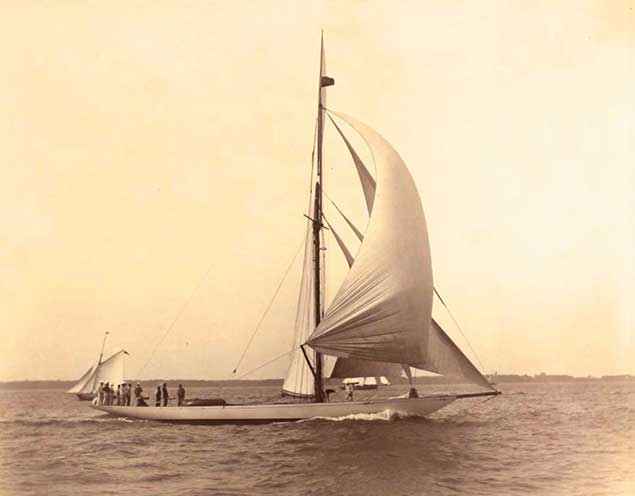 Fast boat, dumpy rig? Peter Donaldson’s successful Isolde of 1895 looked to have a very low-slung rig when she squared off on the run
Fast boat, dumpy rig? Peter Donaldson’s successful Isolde of 1895 looked to have a very low-slung rig when she squared off on the run
It is the famous photo of the new Belfast Lough 25ft One Designs at their start in the RUYC Regatta in July 1898 - their second season – which best shows how gaff rig had developed in the decade since Irex was the boat to beat. The BLOD 25’s have topsails which use long yard to sit as flush as possible with the mast. As the luff length of the topsail was actually longer than the luff length of the mainsail, and as it is luff length which does most of the work in making to windward, getting the topsail and mainsail to set as one was vital in achieving best performance.
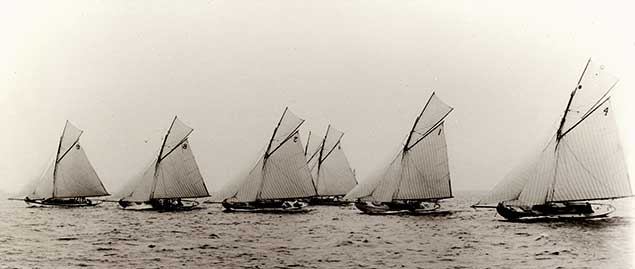 Serious topsails. With a luff length longer than the luff length of the mainsail, the Belfast Lough 25ft ODs had to get the set of their topsails just right.
Serious topsails. With a luff length longer than the luff length of the mainsail, the Belfast Lough 25ft ODs had to get the set of their topsails just right.
In fact, as I learned in my days of racing a Howth 17, fractions of an inch in the location of the topyard halyard and jackyard outhaul on their respective yards made all the difference between having a very effective topsail, and having a heap of rubbish aloft which was only holding you back if the wind freshened on the final leg. You were getting there if, when setting the sails, you could look aloft and see the newly-hoisted topsail set as flat as a board, with even tensions to every corner. This meant that you could ease the mainsail peak halyard just a smidgin to transfer some of the load directly to the topsail, thereby making mainsail and topsail in effect into one sail which happened to have a couple of bits of wood in the middle.
However, despite the favourable impact made by boats such as Isolde and the BLOD 25s, larger yachts tended increasingly to revert to long topmasts in order to make their topsails more effective, and in the most enthusiastic cases, the mastman would be despatched aloft to lace the luff of the topsail to the topmast and the mast itself. This certainly achieved an efficient set for the sail, but was unseamanlike in the extreme, as it totally obviated the topsail’s supposed benefit of being able to reduce sail area aloft in only a few minutes.
Surprisingly enough, it wasn’t until 1912 that designer Charles E Nicholson was allowed by an owner to do away with the cumbersome, eddy-inducing topmast altogether, simply by extending the mainmast in the lightest possible section in a 12 Metre.
Naturally the critics expected the new unfeasibly tall masts to break under the load of the topsails, and some of them did just that. But those tall continuous masts that stayed aloft tended to win races, and so the Marconi mast was here to stay. They were nicknamed “Marconi” masts in acknowledgement of the high aerials required by Italian radio pioneer Guglielmo Marconi (1874-1937), whose mother was a Jameson and whose first radio report of a sporting event was the Royal St George YC Regatta of 1904 in Dublin Bay.
It was only two years after the first Marconi sailing mast appeared in a yacht that the first international racing yacht took the next logical step of making the topsail and mainsail into one, and that yacht was newly-commissioned in 1914 from Fife of Fairlie by an Irish yachtsman, Arthur F Sharman Crawford, Commodore of the Royal Munster Yacht Club on Cork Harbour.
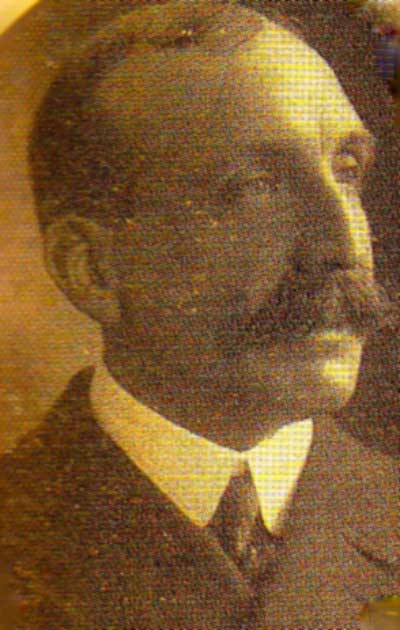 Man of many talents and interests – Arthur F Sharman Crawford contributed much to his adopted home of Cork
Man of many talents and interests – Arthur F Sharman Crawford contributed much to his adopted home of Cork
There’s a book to be written about Arthur F Sharman Crawford (1862-1943), for there’s no way that even a dozen blogs could explain how the Dublin-born English-educated younger son of a northern family with extensive land-holdings in County Down – particularly on the shores of Belfast Lough – came to be the Managing Director of Beamish & Crawford’s brewery in Cork. There, he joined the management team at the age of 28 in 1890, and guided it as Managing Director through some of its most successful periods, and also skillfully negotiated the difficulties of World War 1, the Easter Rising, the War of Independence and the Civil War in a total period from 1914 to 1923, while at the same time being a great benefactor to his adopted city, particularly in the area of technical education, but also in the broader cultural and artistic sphere.
Yet this was no unduly serious do-gooding workaholic. On the contrary, Arthur Sharman Crawford (the family preferred their double surname without a hyphen) was sports mad. A keen yachtsman who was an early owner in the Cork Harbour One Designs of 1896, he was elected Commodore of the Royal Munster YC when it was still at Monkstown in 1898. When it moved to Crosshaven in 1923, as he lived at Lota Lodge in Glanmire north of the harbour, he transferred his full allegiances to the more conveniently located Royal Cork at Cobh where he was already Vice Admiral, and in 1925 he became Admiral and served in that post until 1935.
He also rode to hounds every winter with ferocious enthusiasm, being Joint Master of Cork’s United Hunt for four years. And in later life he played a central role in the establishment of Cork Golf Club, where he served as an actively and frequently-playing President for many years. But in his prime, sailing was his main sport, and he spread his wings far beyond Cork Harbour, for he campaigned on the international scene with a Fife 12 Metre called Ierne, and as a member of many yacht clubs throughout Ireland and Britain, he was a frequent guest helm at regattas, with particularly close associations with the Royal Ulster YC on Belfast Lough.
There, his older brother Robert was Vice Commodore and chaired the committee which oversaw the five challenges for the America’s Cup by Thomas Lipton, the first in 1899 and the last in 1930. The advice of the widely-experienced Arthur was regularly sought by this committee. Yet in other areas of life, there was a parting of the ways between the two brothers. In a time of political restlessness, the northern-based Robert Sharman Crawford was uncompromisingly unionist, and became an active leader in the Ulster Volunteer Force from 1912 onwards. But in the different mood of Cork, the southern-based younger brother had a more accommodating attitude towards Home Rule, reflected in the fact that he continued to play a public role in Cork life, and all his branch of the family were at their deaths buried in the family plot on Little Island in Cork Harbour rather than in the ancestral family lands at Crawfordsburn in County Down.
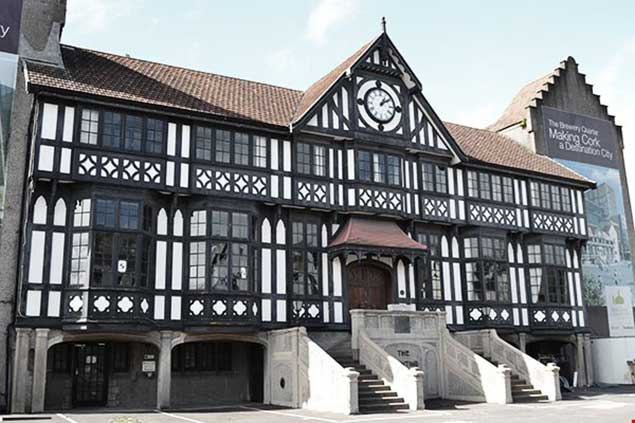 The distinctive Beamish & Crawford Counting House in Cork was built in 1918 during Arthur Sharman Crawford’s long period as Managing Director of the brewery
The distinctive Beamish & Crawford Counting House in Cork was built in 1918 during Arthur Sharman Crawford’s long period as Managing Director of the brewery
There was a very pointed irony in the brothers’ relationship, for even as the brewery in Cork prospered under Arthur’s stewardship, the inherited income from the Crawford estates in the north was shrinking thanks to longterm effects of the activities of Michael Davitt’s Land League and the resultant Gladstone-inspired Land Acts of 1896. The dividends from Cork became an increasingly important part of Robert Sharman Crawford’s income to maintain his opulent lifestyle as a leading yachtsman and as Lord of the Manor of the new loughside Crawfordsburn House, built in the late 1890s to the designs of Vincent Craig. He was the architect brother of Northern Ireland’s future first Prime Minister James Craig (another sailing enthusiast), and his considerable architectural talents were at the same time being deployed for the design of the new Royal Ulster Yacht Club building, which opened in April 1899.
By 1912 and the public declaration of the Ulster Covenant with Robert Sharman Crawford a leading signatory, the fact is that his way of life was largely supported by Beamish & Crawford dividends. It seems only ironic in hindsight – at the time, everyone on all sides though they were doing the right thing. It is only in looking back from the distant and safe viewpoint of 2017 that we realise how curious it was that 104 years ago in 1913, when Colonel Robert Sharman Crawford put his own-funded brigade of the Ulster Volunteer Force through their parades, manoeuvres and exercises on the lawns and fields of Crawfordsburn House, it was all being largely paid for by the continued devotion of the Beamish stout drinkers of Munster.
Yet in that dreamlike pre-World War I era, such activities still seemed slightly theatrical and unreal, and normal life went on at an even more determinedly enthusiastic pace than ever. Having finally agreed a Measurement Rule with the defenders, early in 1914 Thomas Lipton’s latest America’s Cup Challenger, the Charles E Nicholson-designed Shamrock IV, was nearing completion in the south of England. And in the Fife yard in Fairlie in Scotland, a new William Fife designed yacht with an experimental rig was under construction for Arthur Sharman Crawford.
For although Lipton’s technically advanced Shamrock IV carried a very sophisticated gaff rig, it was a gaff rig nevertheless. Thus Arthur Sharman Crawford’s new boat was more important in terms of overall technological development. A more manageable 8 Metre after several successful but demanding years with the 12 Metre Ierne, the new Ierne II was the first yacht to the International Rule of 1907 to set a Bermudan rig.
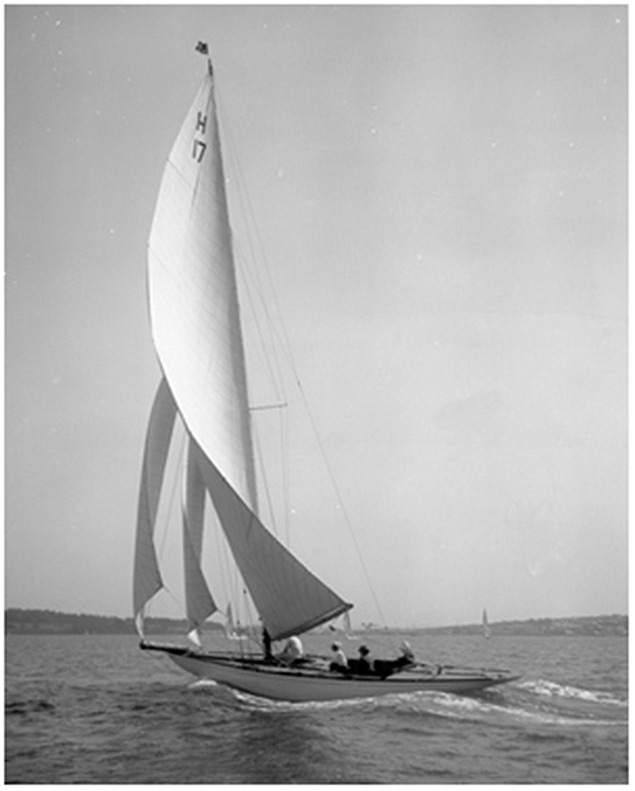 Arthur Sharman Crawford’s 8 Metre Ierne II in 1914, when she was the first International Rule yacht with Bermudan rig.
Arthur Sharman Crawford’s 8 Metre Ierne II in 1914, when she was the first International Rule yacht with Bermudan rig.
Why is she almost totally forgotten in Ireland? Well, Arthur Sharman Crawford led a sort of sailing double life, or even treble life. At home in Cork Harbour, his sailing was local, often using local boats. On Dublin Bay and particularly in Belfast Lough, he was associated with the Lipton camp. But on the Clyde or in the Solent, he was the international or even supra-national yachtsman Arthur Sharman Crawford, challenging the top talents at a rarefied level which was remote from the more localized approach of Cork Harbour or Belfast Lough, and at a tasteful remove from the razzmatazz of Lipton’s America’s Cup challenges.
So when Ierne II appeared fresh out of the wrappers to surprise everyone in the Solent in July 1914, she had never been anywhere near either Belfast Lough or Cork Harbour. It was in the Solent that she made her debut, and for a few very encouraging weeks, while she was undoubtedly a very different creature to sail than a gaff-rigged boat, she was out-performing them all to windward.
It’s intriguing to reflect that when Ierne II was being admired as the hottest new boat in Cowes in late July 1914, briefly in the same harbour at the same time we would have seen Erskine & Molly Childers’ Asgard and Conor O’Brien’s Kelpie pretending to be leisurely cruisers going gently about their business, when in fact they were bound for the Ruytigen Lightvessel to collect their cargoes of Mauser rifles.
Within a couple of weeks, everyone’s plans were in disarray with the outbreak of World War I. All the key figures in the Asgard/Kelpie adventure quickly found themselves positions with the Allied Forces. As for Arthur Sharman Crawford, at the age of 52 this was not an immediate consideration, but his plans for a new programme of fresh excitement for a keen yachtsman past what was then considered the prime of life simply evaporated. Cowes Week 1914 was cancelled completely, and Ierne II was denied the stage which would have provided the setting to enable her to claim her rightful place in sailing history.
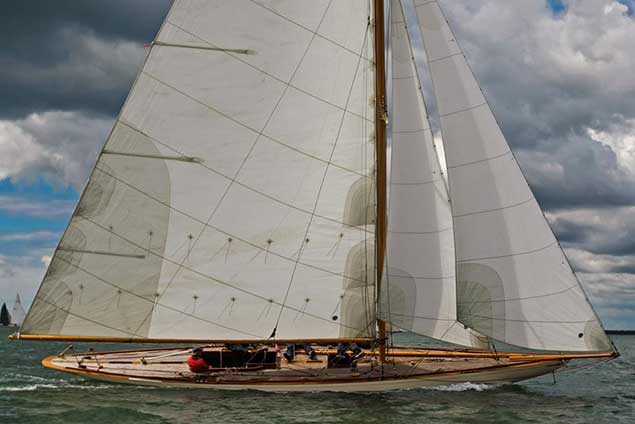 The restored 8 Metre Ierne II is a vivid reminder of Arthur Sharman Crawford’s pioneering instincts.
The restored 8 Metre Ierne II is a vivid reminder of Arthur Sharman Crawford’s pioneering instincts.
Indeed, it was only when noted Yorkshire sailor Hew Jones spotted her laid up in Portugal in 2005 and set about a restoration on Humberside that the whole astonishing story was revealed. When World War II ended in 1918, anyone running a business in Cork amidst Ireland’s growing troubles had other things on his mind, and Arthur Sharman Crawford put Ierne II – laid up since the beginning of August 2014 – on the market. She was eventually bought by Norwegians who wanted a boat for the 8 Metre Class in he 1920 Olympic games in Belgium, and they struck gold in every way, as Ierne II won the Gold Medal.
The top racing sailors were increasingly convinced that Bermudan rig would be where it was at, but in the post war recession, progress was slow. Nevertheless, it was another Irish owner who led the way in the south of England. Elizabeth Workman was the widow of one of the founders of the Workman Clark shipyard in Belfast, and as they at least had done well out of the war, she had the resources to re-commission her 112ft gaff cutter Nyria, designed by Charles E Nicholson and built by Camper & Nicholson in 1906.
Nyria was Solent-based, and following the success of Ierne II and other newly-Bermuda rigged smaller boats in the 1920 Olympics, Elizabeth Workman took the mighty step of getting Charles Nicholson to kit out Nyria with Bermudan rig for the 1921 season, making this the first internationally recognized “big yacht” to do so.
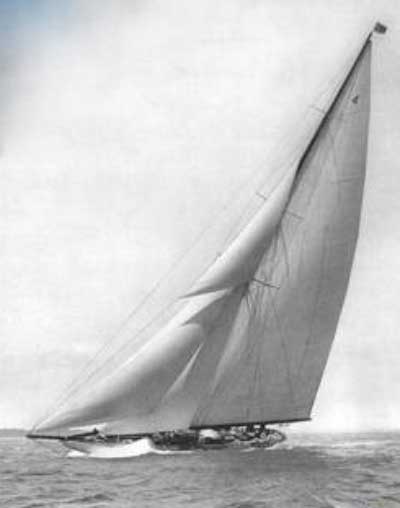 Nyria, owned by Elizabeth Workman of Belfast, in 1921 became the first “big yacht” to be kitted with Bermudan rig
Nyria, owned by Elizabeth Workman of Belfast, in 1921 became the first “big yacht” to be kitted with Bermudan rig
The corner towards Bermudan rig was being turned, and yet another impulse came from Ireland , this time with the commissioning of the world’s first Bermudan-rigged One Design class. The lively Belfast Lough sailing scene of 1914 had been largely destroyed in the trenches of the Somme by the time peace returned in 1918. In an exchange of letters in 1919, some of the more senior members of the Royal Ulster wrote about the need for a new class of boat “which could be sailed by a man and his daughters”. Far from being a gesture for women’s rights, this was simply a sad admission that so many young sailing men would never return from Flanders fields and northern France that it would be 1925 where anything approaching normal manpower levels in sailing would be regained, and so in 1921 the Alfred Mylne-designed Bermudan-rigged 29ft River class made their appearance on Befast Lough. They have never known any rig other than Bermudan, and they continue racing today, though now based on Strangford Lough.
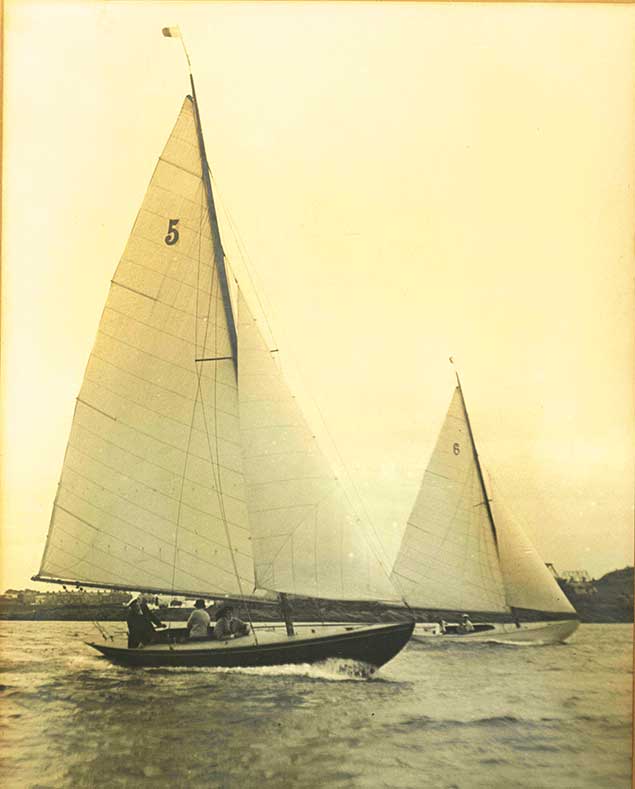 The River Class, seen here racing in Befast Lough in 1921, were the world’s first Bermudan-rigged One Designs.
The River Class, seen here racing in Befast Lough in 1921, were the world’s first Bermudan-rigged One Designs.
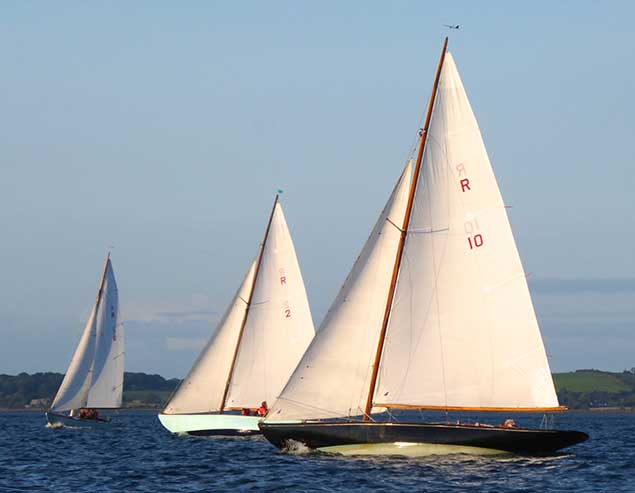 The River Class as they are today in Strangford Lough after 96 years of setting Bermudan rig
The River Class as they are today in Strangford Lough after 96 years of setting Bermudan rig
Thereafter, the move towards Bermuda rig was inexorable and seemingly irreversible, even though sailors as experienced as Billy Mooney of Dublin were ordering the gaff rigged ketch 42ft Aideen to be built by Tyrell’s of Arklow in 1934, and he sailed her so well that he won his class in the 1947 Fastnet Race.
But others were more restless. Since 1898 the gaff-rigged Howth 17s had been sporting their jackyard topsails at their home port north of Dublin, and in 1907 the Dublin Bay Sailing Club adopted the same design, and proprietorially re-designated them as the Dublin Bay 17s. Not only that, but in 1936 a young and competitively successful Dun Laoghaire owner, Terry Roche, decided he would lead the way by converting his DBSC 17 Eileen to Bermudan rig. Despite the fact that she now carried lee helm as he would also have had to move the mast aft to make the new rig balance, he doggedly sailed her to Holyhead and back to prove that all was well. But nobody followed his lead, and after this rather expensive experiment, Eileen reverted to gaff rig and successful racing the following year, and the only lasting memorial of this project is the quaint photo of the Dun Laoghaire waterfront in 1936, a classic image worthy of Cartier-Bresson, with the Water Wags racing off the Royal Irish YC beyond, while in the left of the photo is Eileen sailing under Bermudan rig using mainsail only, which probably balanced quite nicely.
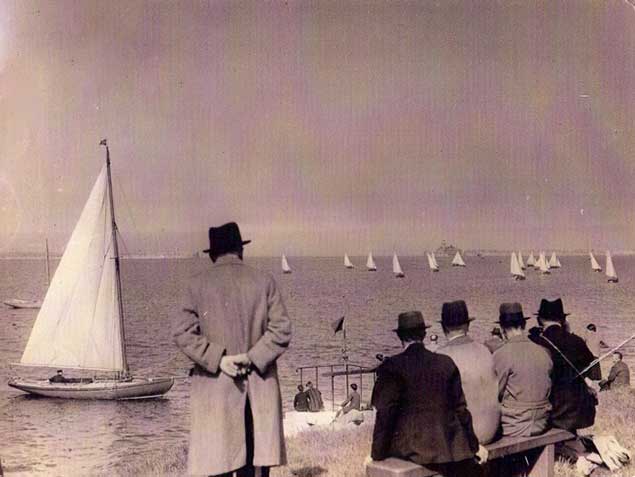 A quirky photo worthy of Henri Cartier-Bresson. The waterfront at Dun Laoghaire in the summer of 1936, with the Water Wags beyond racing off the Royal Irish YC, and on the left Terry Roche’s Howth/Dublin Bay 17 Eileen in her brief but expensive flirtation with Bermudan rig.Photo courtesy Hilary Keatinge-Roche
A quirky photo worthy of Henri Cartier-Bresson. The waterfront at Dun Laoghaire in the summer of 1936, with the Water Wags beyond racing off the Royal Irish YC, and on the left Terry Roche’s Howth/Dublin Bay 17 Eileen in her brief but expensive flirtation with Bermudan rig.Photo courtesy Hilary Keatinge-Roche
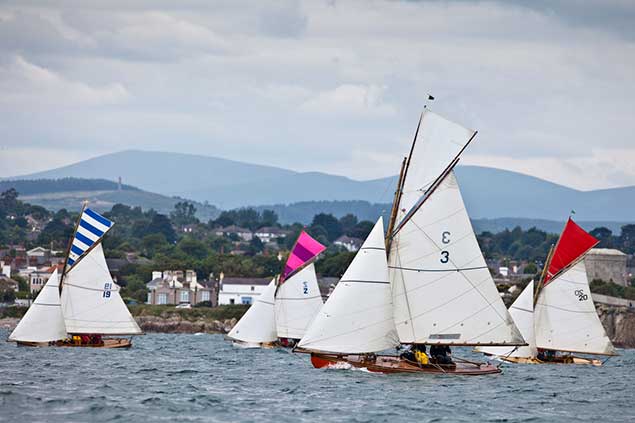 Howth 17s at Dun Laoghaire again, but this time rigged as nature intended, complete with jackyard topsails. Photo VDLR
Howth 17s at Dun Laoghaire again, but this time rigged as nature intended, complete with jackyard topsails. Photo VDLR
Yet other classes such as the Belfast Lough Island class yawls changed to Bermudan rig in the 1930s, but in Dublin Bay the honour of the gaff rig was stubbornly carried until 1963 by the Dublin Bay 21s, when after sixty years of gaff they converted to Bermudan rig which gave have them another 23 years of active racing life.
Typically of everyone being out of step except Dublin Bay, 1963 was also the very year in which the Old Gaffers Association was founded simply to preserve gaff rig. Ironically, gaff rig is now more visible than ever, albeit above plastic hulls. After all, there are more than a thousand gaff-rigged Cornish Shrimpers sailing the sea.
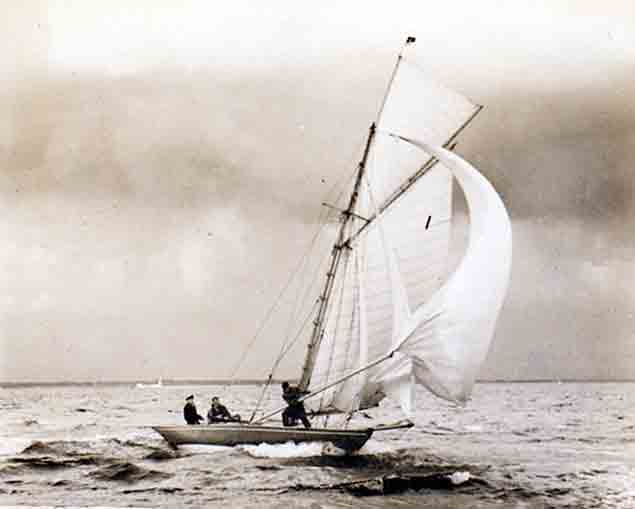 Dublin Bay 21 in full gaff rig glory
Dublin Bay 21 in full gaff rig glory
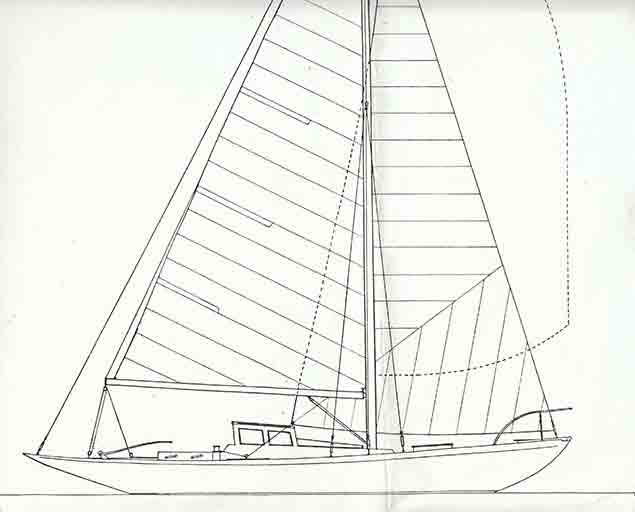 It is 1963, the Old Gaffers Association has just been formed, yet in Dun Laoghaire in 1963 the Dublin Bay 21s make their debut rigged like this……..
It is 1963, the Old Gaffers Association has just been formed, yet in Dun Laoghaire in 1963 the Dublin Bay 21s make their debut rigged like this……..
So is it coming full circle? Maybe. After all, when the America’s Cup multi-hulls start strutting their stuff on Great Sound in Bermuda, they’ll be setting square-headed mainsails which are gaff rig in any sensible definition. And all that where Bermuda rig as we knew it for so long originated more than 183 years ago……
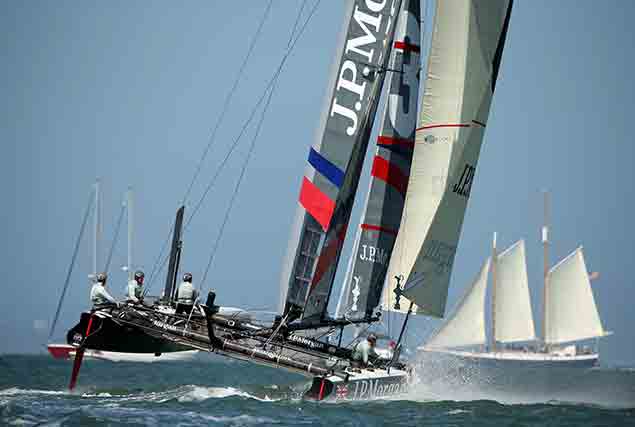 When gaffers meet….one of Ben Ainslie’s America’s Cup boats making knots towards another old gaffer
When gaffers meet….one of Ben Ainslie’s America’s Cup boats making knots towards another old gaffer
But the real test is on Cork Harbour. The reversion to gaff rig came centre stage there last year when the new Ultra National 18s decided the only way to make their otherwise state-of-the-art boats truly sexy was to give them trendy square-topped mainsails.
And if by any chance the spirit of Arthur Sharman Crawford still sails about Cork Harbour, the place he came to love so well, I’ve no doubt he’ll be doing it aboard a ghostly Ierne XXX under a spectral square-topped mainsail, occasionally waxing nostalgic about the old days when he sailed Ierne II with a quaint three-sided mainsail.
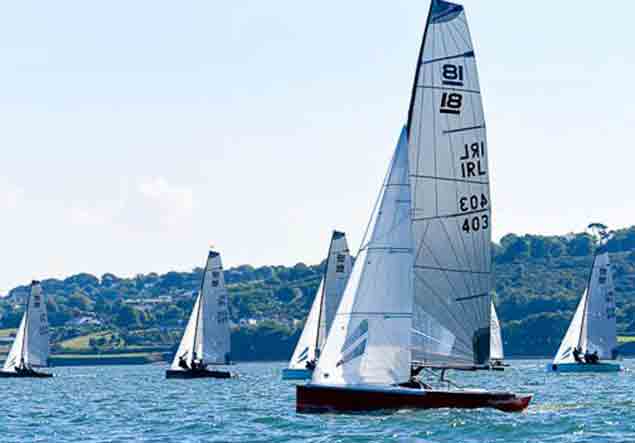 Being fashionable. In 2016, the National 18s Ultras in Cork Harbour reverted to “gaff rig”.
Being fashionable. In 2016, the National 18s Ultras in Cork Harbour reverted to “gaff rig”.
Cruise Evening Highlights Celebrity Calls to Capital
#CruiseEvening - A cruise evening event was held earlier this week in a south Dublin yacht club to promote a major US brand operator, writes Jehan Ashmore.
The event organised by Cruisescapes was held at the Royal Irish Yacht Club, Dun Laoghaire, where Lorraine Quinn of Celebrity Cruises gave an informative presentation about their cruise line and destinations.
As Afloat previously covered in November, Celebrity Cruises is to become the first major cruise line to confirm Dublin Port as a 'home' port when a ‘Solstice’ class ship will call to the capital during early summer 2018.
For five sailings in 2018 commencing on 30 April, throughout May and until the end of June, Celebrity Cruises will offer from Dublin direct cruises to ports of call throughout northern Europe.
Afloat subsequently identified the ship to be deployed out of Dublin as the 2,800 plus capacity Celebrity Eclipse which will be a 'game-changer' for the capital port. The move is worth an estimated €6 million to Dublin and the surrounding region in knock-on economic benefits.
So far the take up for this new direct option according to Celebrity Cruises is that 20% of customers will be from the Irish market. A further 20% are from the rest of Europe and the balance of 60% from the US.
As for season 2017, Celebrity Eclipse will call to Dublin Port on standard port of call visits as distinct to been ‘home' ported.
Another Solstice class sister, Celebrity Silhouette is also call to the capital on such a basis as well to visiting Belfast, Cork and Waterford.
2018 SB20 European Championships To be Hosted By Royal Irish Yacht Club
The 2018 SB20 European Championships will be hosted by the Royal Irish Yacht Club in Dun Laoghaire it has been announced.
The Irish staging of the event in two years time will be in the same year as the World Championships are heading down under to Tasmania.
Next year's Europeans are in Cowes and the Irish class is hoping to attend the British south coast event in numbers in antcipation of the 2018 Dublin Bay fixture. The Irish class is keen to recruit new blood to contest the Irish event and noting top secnod hand boats are available to buy at around £10,000stg.
Royal Irish Yacht Club to Host DBSC Turkey Shoot Sailing Series
The Royal Irish Yacht Club is hosting this year's Dublin Bay Sailing Club Turkey Shoot Sailing Series from Sunday 6th November to Sunday December 18th.
- Entry forms and the NOR is downloadable below.
A series of seven races to be held on Sunday mornings (First gun 10.10 hrs) under modified ECHO.
'Cruisers, cruising boats, one-designs and boats that do not normally race are very welcome', according to DBSC race organiser Fintan Cairns.
As a DBSC incentive to get people sailing, a boat that takes out a non–sailor (new to sailing) will get a 2% discount on it’s handicap that day. The non-sailor will qualify as such for 3 races if taken. There may be overlaps with non-sailors so rules will again evolve! Names must be registered before racing on the day. Cairns says the rule should be 'used in the spirit meant'.
Dun Laoghaire's Irish National Sailing School has been quick off the mark to launch a 'Turkey Shoot Sailing package' for beginners, providing tuition and racing each Sunday in a 1720. Full details on this INSS package here.
Entry fee to the series at €70.00 – includes temporary membership of Dublin Bay SC and Royal Irish YC
Entry forms and the NOR is downloadable below.
Sailing instructions will be available on Sunday 6th November and will be emailed to entrants beforehand.
After sailing, food will be available to competitors in the Royal Irish YC
Conor O’Brien Ketch Ilen’s Deck to Be Completed By Mid-October
The re-decking of the 57ft Conor O’Brien ketch Ilen (originally built Baltimore 1926) is the latest stage of this major restoration/re-build project to be nearing completion at Liam Hegarty’s boatyard at Oldcourt on the Ilen River between Skibbereen and Baltimore writes W M Nixon. It is expected that the deck will be signed off by October 15th, and work will then proceed on more detailed work.
As part of the project, the new bowsprit – built by trainees in the Ilen Boat-building School in Limerick – was delivered down to Oldcourt last Saturday, and Ilen School Director Gary MacMahon reports a magic moment when Baltimore sailing legend Dermot Kennedy, owner himself of a similar ketch the Richard, called by Oldcourt on Saturday to give the deck his blessing and welcome the bowsprit to West Cork.
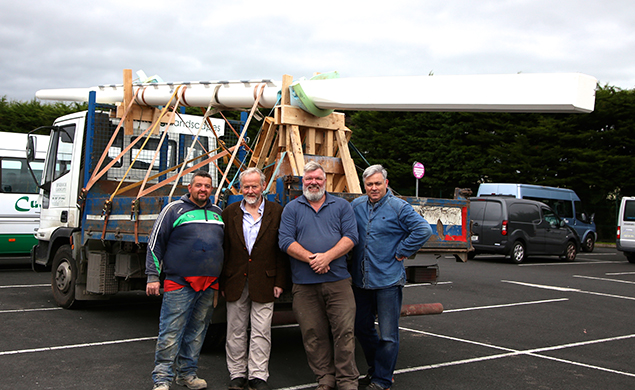
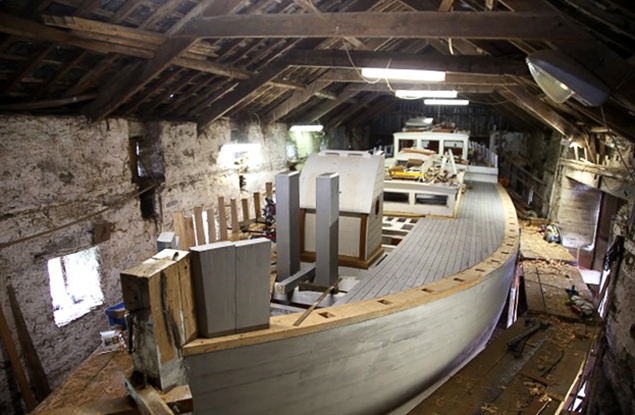 Combined effort. While the hull and deck of the Ilen have been re-constructed in the boatyard at Oldcourt in West Cork, all the deckhouses and hatches have been built in the trainee workshops of the Ilen Boat-Building School in Limerick. Photo: Gary MacMahon
Combined effort. While the hull and deck of the Ilen have been re-constructed in the boatyard at Oldcourt in West Cork, all the deckhouses and hatches have been built in the trainee workshops of the Ilen Boat-Building School in Limerick. Photo: Gary MacMahon
All the deckhouses, hatchways and similar “cabinet” work in the Ilen project has been done in Limerick and then trucked to Oldcourt. There, the main part of the hull and deck re-building has been progressing steadily, sometimes drawing on the talents of international traditional boat-builders who have been enticed to the magnet of West Cork by the quality and scale of the workmanship being produced by Liam Hegarty and his team.
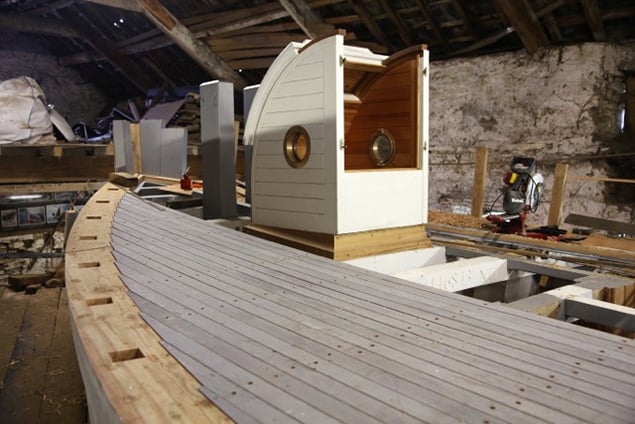 While you wouldn’t expect to find a forehatch like this on a modern offshore racer, on the traditional ketch Ilen the new Limerick-built forehatch housing looks very much at home. Photo: Gary MacMahon
While you wouldn’t expect to find a forehatch like this on a modern offshore racer, on the traditional ketch Ilen the new Limerick-built forehatch housing looks very much at home. Photo: Gary MacMahon
IIen was originally commissioned in 1925 by the Falkland Islanders to be their inter-island communications vessel after they had been properly impressed by her smaller sister, Conor O’Brien’s own-designed 42ft ketch Saoirse, which called to the Falklands in 1925 after rounding Cape Horn during his pioneering global circumnavigation.
O’Brien agreed to be involved with the Ilen project with Tom Moynihan the master shipwright of Baltimore, and then when the vessel was completed, her sailed her out to the Falklands. Because his only qualification was as a yachtmaster, for the delivery voyage the Ilen had to be registered as a yacht for insurance purposes, and she made the voyage under the burgee of the Royal Irish Yacht Club.
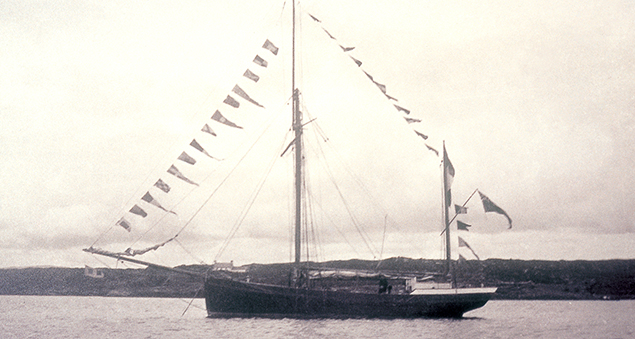 The Ilen on her launching day at Baltimore, 1926. She had to be registered as a yacht for insurance purposes, as her skipper Conor O’Brien’s only qualification was as a yachtsmaster, so he made the delivery to Ilen’s new owners in the Falkland Islands sailing under the burgee of the Royal Irish YC. This also obliged him to carry the RIYC’s then-recognised British blue ensign. But a look at this photo soon reveals the Irish ensign under the bowsprit, celebrating the fact that in making his 1923-25 circumnavigation with Saoirse, Conor O’Brien became the first captain to sail on any major voyage under the Irish tricolour
The Ilen on her launching day at Baltimore, 1926. She had to be registered as a yacht for insurance purposes, as her skipper Conor O’Brien’s only qualification was as a yachtsmaster, so he made the delivery to Ilen’s new owners in the Falkland Islands sailing under the burgee of the Royal Irish YC. This also obliged him to carry the RIYC’s then-recognised British blue ensign. But a look at this photo soon reveals the Irish ensign under the bowsprit, celebrating the fact that in making his 1923-25 circumnavigation with Saoirse, Conor O’Brien became the first captain to sail on any major voyage under the Irish tricolour
Junior Sailors Set Sail at Royal Irish Yacht Regatta
The Lansdowne Partnership Royal Irish Yacht Club Junior Regatta took place on Wednesday 20th July in challenging and changeable weather conditions.
There were 2 courses, one inside the harbour for the Optimist Regatta fleet and one outside the harbour for the Main fleet of Optimists, Lasers, 420's, RS Tera's and PY Classes. Harbour fleet Race Officer, Paddy Lee, managed to get 4 races sailed, only 3 to count, on a course that had to be set taking into account that there were tenders ferrying cruise ship passengers for the day.
Outside the Harbour, Race Officer, Henry Leonard, got three races sailed in varying wind conditions with a number of strong squalls. Both courses had a great days racing with all competitors ashore by 3pm allowing competitors to experience the carnival fun and games on the deck. Prizes were presented by Commodore of the Royal Irish Paul Sherry and Fergal Hopkins from Lansdowne Partnership (below).

The attached results below are prize winners from the day.
Royal Irish Yacht Club C&C30 Races At NYYC Race Week
Royal Irish Yacht Club one design skipper Nigel Biggs was sailing his C&C 30 Checkmate at the North American Championships araced as part of NYYC Race Week at Newport. The crew finished sixth out of nine. Results are here.
Royal Irish Yacht Club Regatta 2016 Results & Photos
27 classes competed in today's Teng Tools sponsored Royal Irish Yacht Club Regatta on Dublin Bay. Having just finished the Round Ireland Race on Thursday, the club's own JPK1080 Rockabill VI (Paul O'Higgins) was back on the water again, winning the 18–boat IRC one division. Full results in each class are downloadable below.
At 704 miles long, with a course along coastlines of almost infinite variety, the Round Ireland Race was always a complex event for post-race analysis even when fleets amounted to only three dozen or so. But for 2016 in the first year of sponsorship by Volvo Car Ireland, the number of starters soared to 63. And the inclusion of multi-hulls for the first time since the initial pre-RORC race of 1980 added further depth to the eclectic nature of the fleet, which was already an extensive array, as it ranged from small craft like a J/97, a First 31.7 and a Sunfast 3200, to one of the current superstars of world sailing, George David’s Juan K-designed canting-keeled Rambler 88. Having provided us with 17 up-dates during the six days of the race, W M Nixon takes a final overview.
Here’s to Yellowbrick, the friend of armchair sailors everywhere. In the old days, trying to analyse or explain the unfolding story of the biennial Round Ireland Race was a formidable challenge. And you could be talking about it to people very few of whom had ever sailed round Ireland, while others didn’t even know it from the land, as they have been availing of sunshine holidays ever since cheap air travel arrived.
Thus there are many who know more of the coasts of Spain, Portugal and Greece – or even the Scottish Hebrides and the Isles of Scilly - than they do of Mayo and Donegal. And having experienced both those Irish counties in their more perverse meteorological moods in the course of several races round Ireland - not to mention many non-racing cruising circuits – I have to admit that I can see their point of view.
The Yellowbrick tracker for the Volvo Round Ireland Race 2016 wraps Ireland in its web. TriLogic went furthest east after the start, the three MOD 70s went furthest south off the south coast and furthest west off the west coast, Rambler 88 went furthest northwest, and Pegasus of Northumberland went to the Isle of Man but came back to cross tacks yet again with Teasing Machine, this time at Skerries as the Machine came south from Dundalk Bay.
"Round Ireland 2016 is in a special league of its own"
Yet the round Ireland race is addictive, and for those who have done it in the past, particularly those who have done it several times, it’s a bit of a pang to see the fleet go off and not be part of it. Even with all the modern equipment and boats which are obviously faster, it’s still a very worthy challenge. And it induces a special post-race camaraderie among crews who, in racing terms, have been at each other’s throats since the start.
After each biennial staging, something new has always turned up to add to the sailing history books. But the Volvo Round Ireland Race 2016 is in a special league of its own in this category, so much so that far from just adding something to the history books, it probably deserves a book of its own.
In fact, you could write a book about the fantastic start in which Rambler 88 gave a Masterclass in discerning emerging gaps beginning to appear in a melee of sometimes confused smaller bats. Despite her huge beam she came cleanly through to a peach of a start right on the committee vessel LE Aisling, bettered only by Eric de Turckheim’s A13 Teasing Machine while smaller craft which thought they’d done better found they’d been OCS, which led to a slow and painful return against a strengthening ebb to re-start.
Rambler’s miraculous start, finding gaps where none had existed ten seconds earlier. Photo: W M Nixon
Fortunately in making some sense of what happened afterwards, we can take a precise positional overview by looking at the Yellowbrick tracking as it was at virtual completion yesterday afternoon. It may look like a right cat’s cradle of lines all eventually getting back to Wicklow, but there are stories to be drawn from every part of it.
In the first beat from Wicklow Head down to the Tuskar Rock, very few boats tended to the east, and it certainly didn’t pay off. The one who went furthest east was the 50ft Trilogic, Hugo Carlsson-Smythe’s trimaran, which ultimately retired during the course of the race with gear and sail problem, so we don’t know if ultimately she would have overcome this initial tactical error.
The mono-hull which tacked furthest east was Chris & Patanne Power Smith’s J/122 Aurelia (RStGYC), but she then put in a good showing in the long beat along the south coast and got herself back in the hunt, although off the north and east coasts things didn’t go quite so well, but in the end she placed 3rd in IRC 2 and 18th in IRC overall.
"Teasing Machine made a proper job of tide-dodging"
While the bulk of the fleet were still struggling against foul tides down the Wexford coast with Teasing Machine showing how to make a proper job of tide-dodging inside the Wexford banks, out ahead the biggies were splitting into their two parts of this fleet of four parts.
Although the reckoning was that conditions might just fall the right way for a new record, the three MOD 70s first had to find a breeze to raise them above the 12 knots which they occasionally fell back to as they came on starboard out past the Coningbeg Light. Thus it’s Musandam-Oman, Phaedo and Concise which are those three tracks which go way to the south. As they were so close to each other in performance, they sailed as a pack, so there was an element of covering as much as strategy in this, but in these early stages it was Ned Colllier Wakefield aboard Concise who was making the pace, with Phaedo next in line, while Musandam seemed to find it difficult to obtain quite the same speed.
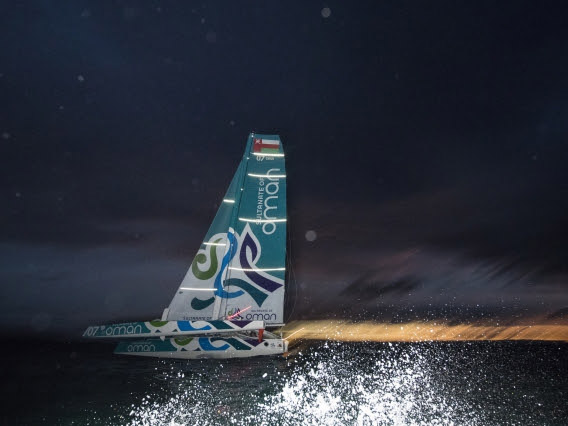
The first hint of light in the east in the sky as the MOD 70 Musandam-Oman closes in on the Wicklow finish for a last-minute takeover of the line honours lead on the water, after her sister-ship Team Concise had led for most of the race. Photo: Mark Lloyd
Perhaps Irish sailing superstar Damian Foxall aboard Musadnam was slightly over-awed by it all, as he hadn’t been aboard Musandam when she set the new open Round Ireland record back in May 2015, and in an interview before the race (see below), he revealed that he and Justin Slattery – who was on Lloyd Thornburg’s Phaedo - were both Round Ireland virgins. They’ve been so busy building their international careers in other parts of the world that racing round their home island had never come up on the radar.
Whatever the reason, it was Concise which was least fazed by the challenge, she stayed closely in the lead, and after they’d tacked and started ripping up the west coast in the rising sou’west winds of Sunday, it was Concise which recorded the MOD 70’s best speed of 41.56 knots. But as they admitted afterwards, they weren’t right on the edge when they his that mega-speed in a growing Atlantic swell – they were beyond it.

Just outside a two day elapsed time, George David's Rambler looked every inch a winner in her debut Round Ireland race. Photo: Afloat.ie
After her glorious start ten minutes ahead of the MOD 70s, Rambler was going so well in the moderate southerly that she was past Arklow before the trimarans came through, but soon they’d disappeared ahead, and thus for the reminder of the race Rambler 88 was entirely on her own, thereby providing Part 2 of our four part round Ireland fleet. Although she’d been holding the IRC overall lead for a while, at various stages she’d dropped back as smaller craft got clear of foul tides. But once she was past the Fastnet and beginning to build her speed up the west coast in rising breezes, she was soon featuring among the front runners on all counts.
If anything, the weather felt almost Autumnal off the west coast, it had seemed slightly spring-like as warmer weather spread in while the leading big boats were far at sea seeking breezes off the south coast, and there was decent sunshine while the larger boats of the fleet were shuttling from Dun Laoghaire down to Wicklow on the Saturday morning for the start. But on the Thursday night in Dun Laoghaire when it was open house at the Royal Irish YC to meet the heavy hitters, a local weather anomaly was giving a temperature of 9 degrees Celsius which had been winter by anyone’s standards, it was certainly experienced but fortunately it wasn’t to occur again.
With the leading big boats zapping up the west coast on Sunday as south to sou’west winds continued to freshen, records were once again top of the agenda. But this was all of academic interest to the main part of the fleet bashing its way along the south coast, for as Sunday went on, conditions became increasingly rugged. Yet it was not without its local oddities – for a period on Sunday afternoon, there was very little wind indeed in an area close in on the entrance to Cork Harbour, and the spread of breeze was so uneven that the tracker revealed some boats taking rather desperate gambles to try and find steadier conditions.

Mark Mansfield and Maurice “The Prof” O’Connell on Dave Cullen's J109 Euro Car Parks, the IRC3 winners. Photo: Afloat.ie
One boat which did notably well during this stage was Dave Cullen’s J/109 Euro Car Parks. With Corkmen Mark Mansfield and Maurice “The Prof” O’Connell calling the shots, they gave a masterful demonstration of how to work the bays slugging west beyond the Old Head of Kinsale.
“Working the bays” doesn’t necessarily always pay off, and in fact it didn’t work so well for other boats near Euro Car Parks. So clearly an important factor in the successful use of this ploy is to have a boat which is out-sailing everyone else in any case, and it was noticeable by this stage that Euro Car Parks had worked out a formidable lead on all the other J/109s while she herself was in hot pursuit of Paul O’Higgins new JPK 10.80 Rockabill VI, racing with the noted talents of Mark Pettit and Brian Mathews on board.
"Rockabill VI was a very slippy performer"
As Sunday evening and night went on, the Fastnet became increasingly difficult to get past as the area of steadier fresher breeze moved to the north. Thus while bigger boats such as Alan Hannon’s Reichel-Pugh 45 was making hay up past the Blaskets with a performance which suggested that she a going better and better as her Lough Swilly YC crew became accustomed to her ways, back down the line off the mouths of the great rias of the southwest at times the wind was all over the place, and Euro Car Parks was one which suffered, head off south of Dursey Dound, and forced to tack seaward in unspeakably lumpy sailing conditions.
By this time Rockabill VI was showing she was a very slippy performer, and the long run up the west coast was brilliantly sailed by her talented crew, so much so that by Tory Island she’d opened out a lead of 40 miles on Euro Car Parks, which looked unassailable.
But for others even thinking about Tory Island was still way off the radar, as many boats reckoned they’d taken a ferocious battering through the latter part of Sunday, and there were retirals at all levels of the fleet. Meanwhile away to the east the oldest boat in the race, Darryl Hughes’s 1937 Tyrell of Arklow 43ft–gaff ketch Maybird was making only very slow progress and she’d sustained damage aloft and to sails, so she went into Dunmore East and kept the crew strictly on board and out of contact with the shore while they made repairs and then, most gallantly, they put to sea again and eventually after another two days of slow progress to windward they had the freeing of sheets at Mizen Head within sight, but then it was discovered that there was a major problem with the engine, so they retired regretfully into Baltimore.
By this time the great dramas of the record finishes at Wicklow had been played out through Monday. So long as there’s breeze your ordinary North Channel fair or foul tides aren’t the major consideration for he MOD 70s, it’s the presence of wind which is the primary consideration.
Sunday evening found the MOD 70s shaping themselves into the North Channel and fetching through with all still close together and Concise still just leading, but from the South Rock on it was hard on the wind or beating to get to Wicklow. Musandam was still trailing the other two, so she took a brief slant towards Dundalk Bay and then went on to starboard to pace with them about two mioles further westward, bringing her in closer to Howth than Concise or Phaedo, and putting her in a better breeze as the wind started to play tricks in the dark of the small hours off Bray.
Everything was gettingly nail-bitingly tense, and south of Greystones, Phaedo and Concise were slowing markedly, so Musandam came up from astern and took a bit of an offing, finding better breeze only a short distance offshore which carried her right to the line at Wicklow to finish ahead and created an absurd new record of 1 day 14 hours and 37 minutes, with Phaedo 3 six minutes astern, and Concise – which had so gallantly led for most of the race – coming in another minute later.
Follow that, as they say, but somehow Rambler 88 managed to outdo the drama, as she did the final stage from Rathlin Island to Wicklow in just part of the one span of daylight on Monday. But by the time she came calling the wind had veered and thus she was able to lay the whole way down the Irish Sea to the finish, and was travelling at full chat as she came into the line.
While a mono-hull record within two days was no longer possible as she’d sailed 790 miles in all thanks to that long tack to the south in search of better breeze through Saturday night and Sunday morning, nevertheless she still made an almighty dent in every other mono-hull record by finishing in a time of 2 days 2 hours 24 minute and 9 seconds.
There was still some bite to the winds, but even in a poor summer such as we’re currently experiencing, the fact that the sou’west to west breeze had now been blowing moderate to strong and more for more than three days was increasing the likelihood of calm patches, and a general falling away in wind strength.
So gradually the crazy notion took hold that not only would the popular Rambler 88 be lauded as the new all-out mono-hull record holder, but she might even manage to win the race on corrected time. Certainly the holes in the wind now began to appear with increasing frequency, and none more so than for Rockabill VI as she rounded Inishtrahull, the most northerly point of the course, on Tuesday.

Rockabill VI – a new JPK 10.80 design. Photo: Afloat.ie
The O’Higgins crew came up against what was soon known as the Great Glass Wall of Inishtrahull. Rockabill and the three other boats in her immediate neighbourhood all came to such a complete halt that tracker-followers assumed they must all have fouled lobster pots. But they were simply and totally becalmed. They made no progress for three hours, yet boats close to the east were still bustling busily towards Rathlin Island, while boats close to the west were trundling merrily in from Tory.
So after the episodes of winter and spring and autumn, Rockabill was experiencing a brief bit of summer she could have well done without. Finally she got going again, but by this time Euro Car Parks had sliced a huge 20 miles out of Rockabill’s 40 mile lead, and thereafter it was Euro Car Parks ahead in IRC 3 on corrected time. In other classes, solid performances and reliability in strong winds had been rewarded, and in IR2 the beautifully-prepared Cornish-based Swan 47 Sarabande (Rob Mabley) had a lead she held to the finish, while in IRC 4 we were witnessing one of the great performances in the race, with Patrice Carpentier’s Sunfast 3200 GROUPE V tenaciously staying in front throughout, quite a showing as she was also leading the two-handed division.
As the race drew to a close through Wednesday and Thursday for this main part of the fleet, other consistent performances were being rewarded. Eric de Turckheim’s Teasing Machine was both consistent and brilliant, and on Wednesday tacking down the southern part of the North Channel, she was neck and neck with Ross Hobson’s two-handed canting-keeled Open 50 Pegasus of Northumberland.

French entry Teasing Machine was both consistent and brilliant. Photo: Afloat.ie
But while Pegasus elected to continue on starboard right over to the Isle of Man as can be seen on the tracker plan, Teasing Machine’s crew took a completely different choice, they went right to the southwest, and then tacked to curve across Dundalk Bay close past Clogher Head until the two boats met again at Rockabill, following which they paced together down to Wicklow where a bit of slick tacking saw Teasing Machine finish ahead, but by this time it was akin to bear-baiting, as the crew of the big Pegasus were boggle-eyed with exhaustion.
Teasing Machine’s time put her behind Rambler 88 on corrected, so the crazy dream was becoming reality, but that is in no way to detract from the de Turkheim crew’s performance, it was a superb playing of the hand they’d been dealt, They were comfortably ahead of Class 1 and 2, and soon out of sight on the determined little battlers of Classes 3 and 4, who until then had been snapping at their heels.
Meanwhile, between the big’ uns well finished, and the little’ uns still battling far at sea, there were several Steady Eddy performances whose reward was on its way, and none more so than for RORC Commodore Michael Boyd of the Royal Irish YC. His Fist 44.7 Lise was always there or thereabouts, and on Wednesday evening she was off Dublin Bay as the tide turned foul, but she kept beating on steadily towards Wicklow and got finished before midnight with the bonus of a local breeze, and was immediately sitting pretty at second in Class I well ahead of Katsu in third, and looking good for third overall behind Rambler and Teasing Machine.
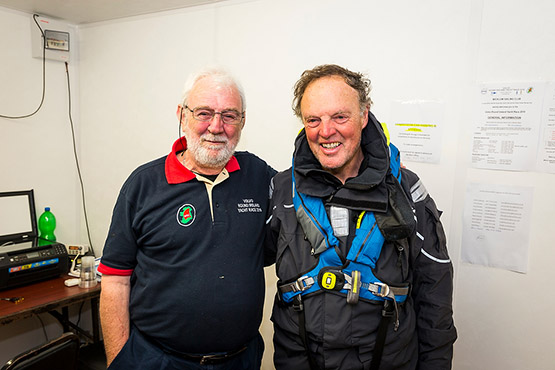
Midnight encounter. Race organiser Theo Phelan with RORC Commodore Michael Boyd after the latter had brought the First 44.7 Lisa across the Wicklow finish line to take third overall. Photo: David Branigan
But that third overall needed a bit of waiting, as the Class 3 front-runners of Euro Car Parks and Rockabill VI were still in with a chance, while Class 4’s GROUPE V and Stephen Quinn’s gallant little J/97 Lambay Rules were also in contention, but it was not to be. The minutes slipped away, the hours ticked by, and in the end over a course of 704 miles it was waterline length which counted as a fading breeze and much windward work saw the little ‘uns lose out. But my word, they had one impressive race amongst themselves.
The results are still being analysed as we write this, and it was only on the Friday that Rambler was finally confirmed as overall winner, with Teasing Machine second and Lisa Third. As for Class winners, they were (1) Teasing Machine, (2) Sarabande, (3) Euro Car Parks, and (4) GROUPE V, but GROUPE V lost her two-handed class lead to Begian Michael Kleinjans’ Open 40 Roaring Forty 2 which was another steady performer.
"All credit to Wicklow Sailing Club’s Theo Phelan and his team"
In all, it was a wonderful race, a magnificent sporting event from which any keen sailor can take much of interest and even more of entertainment and excitement. All credit to Wicklow Sailing Club’s Theo Phelan and his team who have kept this event going through the thin times, and have been ready and waiting to see it come to a new flowering with sponsorship from Volvo Car Ireland.
But all the background organization would have been meaningless without a fleet of boats and their crews game to take on the 704-mile circuit of an island set in an exposed location on the lee side of the Atlantic ocean, and in following this race it has been particularly encouraging to see the improving performances of certain boats as their relatively novice crews get to grips with the challenge they’ve taken on. Needless to say it was also a case of the Old Dog for the Long Road, and Ian Hickey’s Granada 38 Cavatina was again in the frame at the fiish in Class 4.

Top of the class - a notable performance by the sailing school crew from the INSS in Dun Laoghaire. Photo: Afloat.ie
Notably outstanding was the Irish National Sailing School’s Reflex 38 Lynx from Dun Laoghaire, skippered by Kenneth Rumball. She was always in competition, but as the race went on she seemed more in competition than ever, until at the finish she clocked in at fourth among all those hotshots in Class 3, close astern of Conor Fogerty’s Sunfast 3600 Bam at third, and placed tenth overall in fleet. The crew of Lynx have had one excellent lesson in offshore racing.
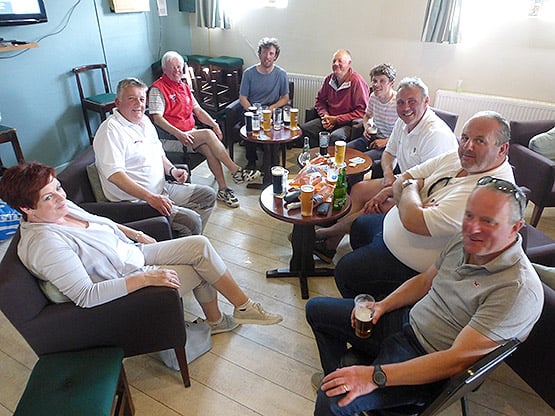
The essential post-race de-briefing – the crews of Euro Car Parks and Rockabill VI, leaders in Class 3, get together in Wicklow SC on Thursday afternoon after five days of racing against each other round Ireland. Photo: W M Nixon
Volvo Round Ireland 2016 selected results
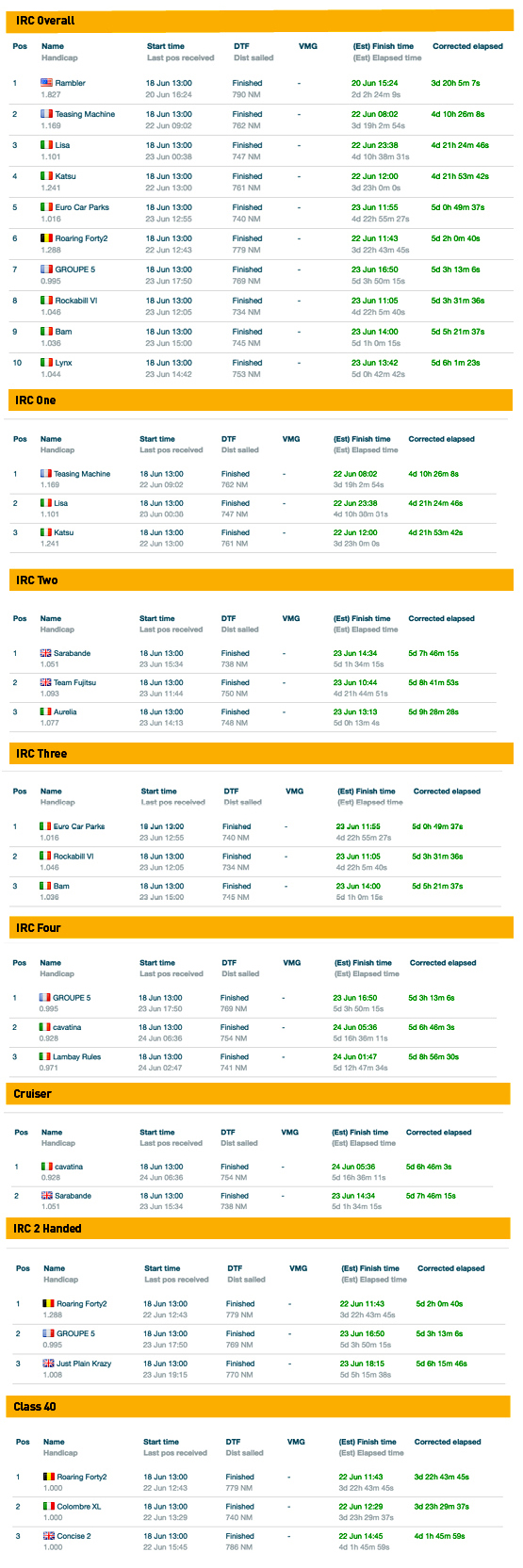
See Round Ireland tracker here Afloat's Round Ireland 2016 coverage is here and download overall results here
New Round Ireland Records Top Of The Agenda At Wicklow Today
Today sees the start off the Wicklow Pierheads of largest and most varied fleet in the 36-year history of the biennial Round Ireland Race from, which in its 19th edition takes on board sponsors Volvo Car Ireland for the first time. The fleet ranges in size from a trio of boats around the 31ft to 32ft band, right up to the 88ft–Rambler, with the three exceptional trimarans of the MOD 70 class next in size. But while attention will inevitably focus on the super-machines at the top end of the fleet, many of those taking part are club sailors from Ireland and overseas, racing standard craft which have only been modified where necessary to comply with the strict R0RC regulations which a race of this calibre requires. As well, the re-birth of local offshore racing in Irish waters is well-reflected with the presence of boats which have been giving a very good showing of themselves in weekend passage races, while boats which performed well in both last year’s Dun Laoghaire to Dingle Race in June and the Rolex Fastnet Race 2015 in August are also very much in contention. W M Nixon gives his take on the mood of the moment, and shares a few pointers for possible top performers.
The international sailing superstars who have come here for the Volvo Round Ireland Race will have experienced many kinds of sailing weather - much of it glamorously and spectacularly sunny stuff - during their hectic careers afloat. But by the time the super-fast leaders are approaching the Wicklow finish line in the early days of next week, they’ll have been able to savour just about everything the Irish climate throws at us, summer and winter……
With most of the top boats assembling as pre-arranged within the ambit of the Royal Irish Yacht Club through this past week, they’ll have shared with the Irish people an almost freakish drop in the temperature as the low pressure area over England, which was in turn sending even worse weather into France for the European Football Cup, began to bring to us here in the Emerald Isle a wet and windy northerly airstream of quite remarkable coldness.
Thursday June 16th – Bloomsday by happy accident – was selected for the evening in which we all could get to know the legends of sailing at an evening reception at the Royal Irish. When the date was being set, you can so easily imagine the organisers visualising a balmy summer evening, with the scene augmented by the DBSC fleet returning to port from their regular Thursday fixture, while on the waterfront terrace of the elegant old yacht club, people could stroll in their summer finery – perhaps we’d even have a Bloomsday veteran or two still properly garbed – and it would be just such a perfect June evening.
But things happened otherwise. Within the already cold northerly airstream, through Thursday a small but always measurable balloon of hyper-cold air between 9 and 11 degrees appeared at the north end of Ireland’s east coast. It spent the day moving southward, remaining remarkably intact in size, and by party time on Thursday at the RIYC it was sitting plumb over Dun Laoghaire, with the temperature at its cold heart now persistently down at 9 degrees.
One of the favourites. Alan Hannon’s clean-lined Reichel-Pugh 45 Katsu in Dun Laoghaire on Thursday evening. Photo: W M Nixon
But anyone who reckons that such a situation would be the ultimate party pooper just doesn’t get it with the kind of people who do the round Ireland, and particularly those who come a long way to take part. They had themselves a ball, they had themselves a blast, and there more were twists and turns to the potential of the Dun Laoghaire-Dublin setup that even the locals would now of.
For instance Brian Thompson, sailing master of Lloyd Thornburg’s all-conquering MOD 70 Phaedo 3, is up to speed on matters Irish, having been a crew-member when Steve Fossett’s 60ft trimaran Lakota established the Ireland circuit record of 1993 which stood for 22 years. So on Thursday night when he heard it was Bloomsday and that that Joyce’s Portrait of the Artist As A Young Man was on at the Pavilion Theatre just across the road, he showed his face for just long enough to be polite at the party in the yacht club, and then skedaddled across the road for a night of high culture.
Meanwhile, RORC Commodore and longtime RIYC member Michael Boyd was settling in very well in the midst of this throng in his home club, working the room and savouring the moment, for nearby on the pontoon was the First 44.7 Lisa which he’ll be skippering round Ireland. He already won the race in 1996 with the J/35 Big Ears, but for the 2016 race he definitely has the more comfortable boat with all mod cons.
The Volvo Round Ireland fleet in stopover mode at the Royal Irish YC in Dun Laoghaire. In the foreground are Michael Boyd’s First 44.7 Lisa, and Paul O’Higgins’ JPK 10.80 Rockabill VI. Photo: W M Nixon
So when it was mentioned that the start of the race at Wicklow is exquisitely timed to exactly match the kick-off in the European Cup’s Ireland-Belgium match in Bordeaux, it didn’t take a feather out of the Commodore, as he cheerfully accepting that the first two hours of the race would be a little slow for Lisa “because only the helmsman will be on deck, the rest of us will be below watching the match”.
His brother Paddy, home from Canada and almost straight into the Round Ireland, will be sailing with Michael together with a formidable crew which incudes the likes of Barry Hurley and Tim Greenwood, so with Lisa well in the frame in the RORC points table, we can be sure that the points weighting of 1.4 which the Round Ireland provides will be treated with the seriousness it deserves.
Nevertheless the idea of watching football matches on a yacht in mid-race just wouldn’t go away, and Paddy recalled the race of 1994 which he did with Mark Mansfield as skipper aboard Brian Buchanan’s Frers 49 Hesperia (overall winner in 1988 with Dickie Gomes as skipper), the boat having become AIB for the duration of the race.
As it happened, that duration wasn’t very long. On the Saturday night they were pacing nicely with Moonduster with the Tuskar astern, both boats turning pleasantly to windward in classic Frers style in abut 15 knots of wind, and all well with the world with the watch off duty (and some of the watch on duty) glued to a little screen in the saloon, where Ireland could be seen playing Italy in the World Cup in the US.
Ireland scored a goal…... From the depths of AIB/Hesperia’s saloon, there erupted a mighty road of approval. And the mast fell down. Just like that. For no clear reason. This has led Paddy to develop a theory that just as an opera singer can shatter a wine glass with a particularly note, so the wild shout of Irish approval for a goal score can bring down a perfectly-tuned mast.
When you’re getting theories like that being learnedly discussed, you get the gist of the party, but there was much more to it than that. Every so often a blast of cold air would erupt into the clubhouse as some new international crew from some boat of legend swept into the party, and I have to tell you that top modern sailors are getting very tall. Not beanpole tall, either. Just big strong tall – maybe they have special breeding programmes to improve the line in France and the US, which is where most of them seem to have originated.
Thus it says much about the size and presence of George David of Rambler 88 that he still stood out in the midst of this crowd of sailing giants in the rather august setting of the RIYC’s stately rooms. He is some piece of work. It’s unlikely he’ll ever apply for the free bus pass for which he qualified a year or two ago, but if Wall Street was ever blown away, he could turn a bob or two as a stand-up comedian. Another option would be a writing a book abut his personal fitness regime, if he has one, for although he’s a big fellow he moves with the grace and ease of someone half his age. And while he’s at that stage in life when most us look at the world through a network of veins, his eyes are as clear as an Optrex ad.
Modern building, very modern boat – Rambler 88 in her Dun Laoghaire berth at the Ferry Terminal. Photo: W M Nixon
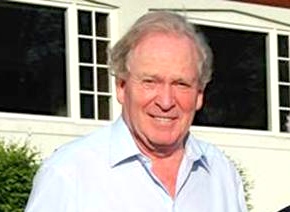
George David, owner-skipper of Rambler 88
As to the business of Rambler 88 breaking the Leopard (Mike Slade) Round Ireland course record of 65 hours from 2008, George David reckons it’s very much on the cards. 2008 was a messy race, with more wind than was useful, and Leopard’s average was only 10.8 knots. But for 2016, Rambler’s skipper figures that if they can make a reasonably efficient job of the uphill sailing to get to the Fastnet, they’ll be looking to average 25 knots along the western seaboard and north coast in strong sou’west to west breezes, and there’s even a chance than once they get near the Irish Sea, the wind will have veered a little more to give them a slant down to Wicklow.
“In most of our races, we expect an average of 13 to 15 knots, and though this can be a difficult course, it’s looking quite good at the moment”. With the Rambler 88 crew including sailors of the calibre of America’s Cup winning skipper Brad Butterworth and Andrew Cape on board, it is indeed looking good.
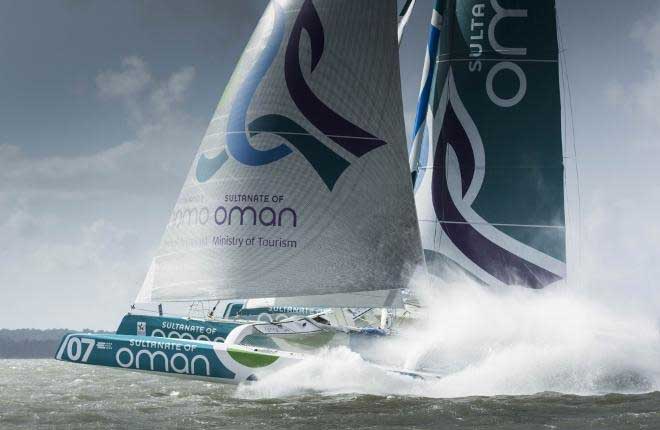
Musandam-Oman in record-breaking form
While Rambler is odds-on to be the first mono-hull to finish, it’s highly likely the oldest boat in the race, the beautifully-restored 43ft Tyrrell ketch of 1937 vintage, Darryl Hughes’ Maybird, will finish last on the water. He found himself in Dun Laoghaire marina berthed just ahead of Sidney Gavignet’s MOD 70 Musandam-Oman, and in the whirl of people up in the clubhouse, the Number One aboard Musandam, Derrynane’s favorite sailor Damian Foxall was relaxed in one of those constantly changing groups which at one stage included Darryl Hughes and northern sailing journalist Betty Armstrong, who is one of the few sailing journalists who has ever actually helmed a MOD 70.
Maybird looking tiny amongst assorted exotica in Dun Laoghaire Marina on Thursday evening. Yet once upon a time in the late 1940s, her sister-ship Aideen (below right) was one of the biggest yachts about the place.
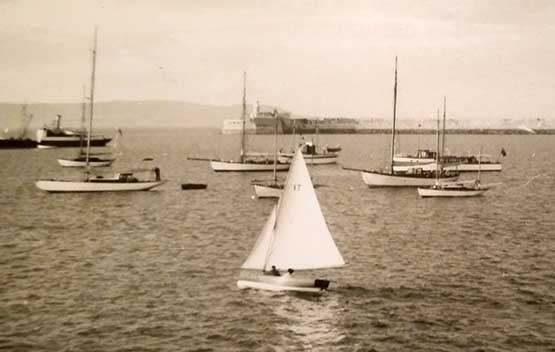
Normally journos are padded up with safety gear like a sack of potatoes on the Mod 70s, for as we learned when one of them capsized in Dublin Bay in 2012, they’re so wide it’s dangerous to fall off them (the MOD 70s, that is…). But out in Valencia, when Betty was the journalist on board Musandam Oman for an inshore race, and she’d found herself a safe spot on the forward netting. Bur there was a straightforward sail back to the harbour, and Damian made his way forward and asked her back to the cockpit, and when she was there, he asked her would she like to helm: “There’s nothing to it”, said he.
So there was Mrs Armstrong of Bangor in County Down helming this wonderful machine at a very smooth 25–knots, and as she says: “Do you know what, there really was nothing to it. The boat was going so smoothly and there was so little feel in the helm that it was only the speedometer which could persuade me I was steering a sailing boat at 25 knots”.
In today’s Volvo Round Ireland 2016 race. they’ll be expecting more than 25 knots and conditions way beyond the “very smooth” once the big multihulls get the Fastnet astern and start to get a bit of north in their course. The weather pattern has moved on a bit from the conditions we were anticipating here on Wednesday, when there was talk of nor’easters at the start giving way to sou’westers by tonight. It now looks as though the ridge which was expected to cross Ireland during today will be slightly earlier than expected, and losing strength in its push to the northeast, thus at start time the underlying wind at Wicklow will be a slack nor’wester
Very soon, however, the weather will be dominated by a big wet low out in the Atlantic, though some comfort can be taken from the fact that pressure won’t become excessively low over Ireland. But the isobars will be close enough together to provide freshening breezes, and well before midnight tonight, the sou’westers will be established at the Tuskar, becoming strong during tomorrow all along the South and West coasts.
Thus getting to the turn in the Fastnet Rock/Mizen Head area is crucial (as it always is), but this year it’s especially the case. And of course while the MOD 70s and Rambler will be looking to have it ticked off well before noon tomorrow, anything much smaller will inevitably be facing a slugging match all the way from somehere north of the Tuskar Rock right down to Ireland’s great southwest capes.
BOATS TO WATCH
With a fleet of 64 boats, it’s impossible to give a complete form guide, so we’ll take ten from the body of the fleet which provide the winning combination of good all-round boats with able crew:
KATSOU (Alan Hannon, RORC & RUYC) This Reichel-Pugh 45 attracted much favourable interested in one of the premier berths at the RIYC on Thursday night, and rightly so. She comes with a good track record, and for this race she has a formidable crew built around the very best of the northwest from Lough Swilly YC, with Richie Fearon navigating (he navigated the winner Tanit in 2014) the winning Clipper Race Skipper Sean McCarter (he also was awarded the Cruising Club of America Rod Stephens Trophy for seamanship last year after successfully dealing with a man overboard in the North Pacific), and also Diarmaid MacAuley, one of the north’s best offshore helms.
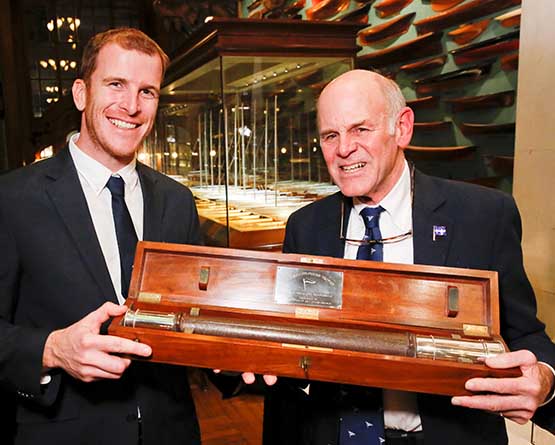
Sean McCarter of Lough Swilly YC receives the Cruising Club of America Roderick Stephens Award from CCA Commodore Tad Lhamon in New York, March 2015. McCarter will be sailing on Katsu during the Volvo Round Ireland Race
LISA (Michael Boyd, RORC & RYC). RORC Commodore Boyd has form in the round Ireland, he won in 1986, and Lisa certainly has form this year in beingin the frame in the RORC Championship. A First 44.7, she should cope well with the expected conditions.
EURO CAR PARKS (Dave Cullen, HYC). Also known as the Kelly family’s J/109 Storm, she has been chartered for this race by World Half Ton Classics Champion Dave Cullen and he has assembled a crew of six champions (himself included) from last weekends ICRA Nats. When you’ve the likes of Mark Mansfield, Maurice “Prof” O’Connell and Johnny Murphy sharing boat space, then good results are expected.
MOJITO (Peter Dunlop & Vicky Cox, Pwllheli SC) They’d a good second in last year’s Dun Laoghaire to Dingle Race, they’re one of the most consistent J/109s around, and they draw their crew from both sides of the Irish Sea in the best traditions of ISORA.
ROCKABILL VI (Paul O’Higgins, RIYC). Still something of an unknown force in her own right, Rockabill VI has the flawless pedigree of being a JPK 10.80 (Fastnet Race winner, Hobart Race class winner etc etc), so as they settle in the O’Higgins crew should move up the rankings
TEASING MACHINE (Eric de Turckheim, France). One of the world’s most sporting offshore racers, this 13m Archambault hs a go at everything from the Commodore’s Cup to the Sydney-Hobart, with a Fastnet thrown in for good measure. She’s always in the frame, she’s an amazing boat, and she and her crew will give of their best.
DESPERADO OF COWES (Richard Loftus, RYS) This vintage Swan 65 would be a good heavy weather selection. And she has a surprisingly competitive rating. She’ll be able to keep going with her crew in relative comfort while smaller craft are bouncing around with crew fatigue becoming a major problem.
AURELIA (Chris & Patanne Power Smith, RStGYC). The Power Smith’s J/122 is the Steady Eddy of the Dun Laoghaire fleet. She was the top-placed non-J/109 in last year’s Dun Laoghaire-Dingle in a race which might have been designed with the J/109 in mind, she has already won ISORA’s biggest race this year, and in all she is a boat which exudes competence.
BAM! (Conor Fogerty, HYC) Athough the Sunfast 3600 Bam! won her class in the RORC Caribbean 600 in February, with her owner subsequently sailing her single-handed from the Caribbean to the Azores when homeward bound, she is not a boat which is suited to the restrictive Irish Sea courses. But the wide open spaces of the Atlantic with winds abaft the beam will enable her to fly – it’s just getting down to the Fastnet that will be the hard bit.
CAVATINA (Ian Hickey, RCYC) The veteran Noray 38 Cavatina is the multiple Round Ireland winner most associated with Eric Lisson, but with her low rating and renowned staying power, if a flat patch happens to slow the whole fleet back, she’s always there, ready to pounce. While it seems unlikely this year, people have got Cavatina’s results prediction wrong before now.
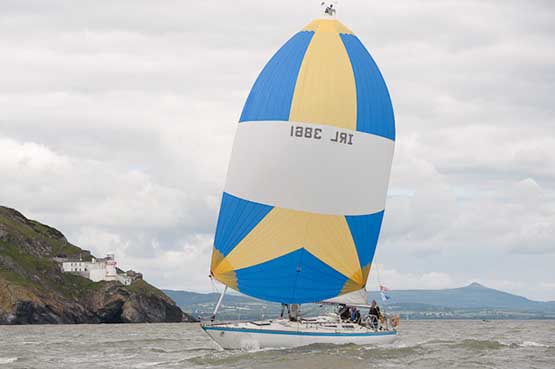
Ian Hickey’s Cavatina (RCYC) off Wicklow Head. She probably holds the record for most Round Ireland races sailed
The Volvo Round Ireland Race 2016 with its record fleet has the task of prediction made more complicated by the many sub-divisions, one of the busiest being the Open 40 Class which is within IRC, yet also races on its own, and for good measure some of the boats are fully-crewed while others are in the Two-Handed Division.
One of the most interesting of the latter is Roaring Forty 2, doing this race as Visit Brussels under the command of Belgian skipper Michael Kleinjans, who also happens to be the holder of the Round Ireland Single-Handed Record, which you can’t really compete for any more, as single-handed record sailing is now officially illegal in Irish waters. But it may well be that Kleinjans and his crew Ian Wittevrongel will set a two-handed Round Ireland Record in this race which will be worthy of future attention.
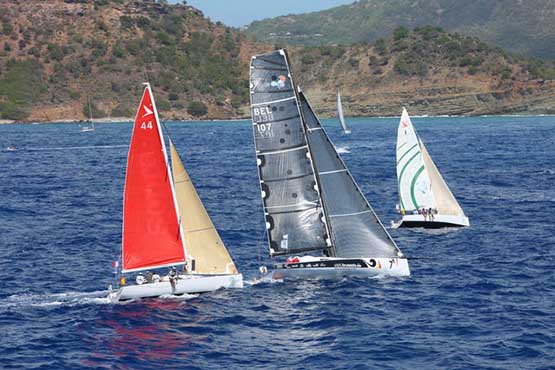 Michael Kleinjens’ Open 40 Visit Brussels will be a favourite for line honours in the two-handed division. She is seen here zapping between two Figaro Solos
Michael Kleinjens’ Open 40 Visit Brussels will be a favourite for line honours in the two-handed division. She is seen here zapping between two Figaro Solos
Meanwhile, we’ll be carrying regular updates and comment on Afloat,ie HERE as the race progresses, based on the Race Tracker. We very much hope that by the time the time the prize-giving comes round in Wicklow on Friday evening, we’ll have mentioned every boat in the fleet at least once. But now, after partying on Thursday night (and a very good party it was too), there’s work to be done today, both off Wicklow and southward down the coast.
And in the end, it will all be in honour of the memory of the great Denis Doyle and his crew for their beautiful 1984 win and course record.
Denis Doyle and his crew aboard Moonduster after their great win in 1984. This photo was taken through glass in Wicklow SC, where it is on display in the Round Ireland Room. Has anyone any idea where the original neg might be sourced?


























